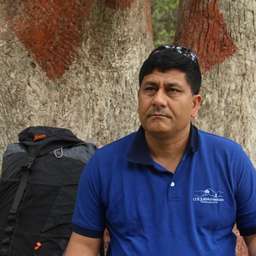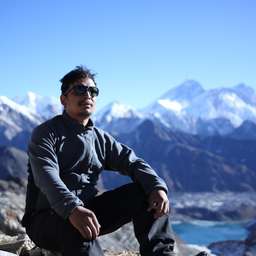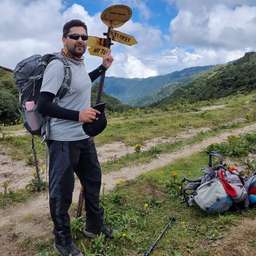Everest Base Camp Trek - Overview
The trek passes through forests, hills and quaint villages and offers ever-changing Himalayan scenery. You get a great sense of anticipation as you trek up the Khumbu Valley, passing through Sherpa villages and Tibetan monasteries, all towered over by some of the most majestic mountains in the world. Spend your evenings lounging by the fire while having a home-cooked dinner, sipping Sherpa tea and chatting with trekkers who share your interest.
Other prominent peaks visible during the Everest Base Camp hike, besides Mount Everest, include Lhotse (8,501m), Makalu (8,463m), Cho Oyu (8,153m), and Ama Dablam (6,856m).
| Everest Base Camp Trek - Trek Facts | |
|---|---|
|
Trek difficulty: |
Moderate to difficult |
| Trek duration: | 12 days is the most common duration but can be anywhere from 8 days to 25 days. |
| Popularity: | Very popular trek but in some quite remote areas. |
| Max altitude: | 5,644m, Kala Patthar |
| Accommodation: | Accommodation ranges from basic tea houses & lodges to moderately priced lodges to high-end lodges/hotels in a few select locations on the EBC trekking trail. High-end accommodations are available in Lukla, Monjo, Namche and Pangboche and are offered by either Summit Lodges and/or Yeti Mountain Homes |
| Best season: | March–May and September–November |
| Transport to/from trek | Flight to the village of Lukla (2,860m) from Manthali Airport in Ramechhap during the high season (March to May and September to November) due to high air traffic. In other months, the flights are regularly operated from Kathmandu Airport. Also accessible by taking a bus to Shivalaya and then a few days of trekking up to Lukla |
| Required permits: |
|
Everest Base Camp Trek - Itinerary
You can complete an Everest Base Camp trek in 2 weeks. But if you don’t have much time, you can go for a short Everest Base Camp trek of under 10 days. The standard trekking itinerary for the Everest Base Camp Trek is 12 days long. However, it may vary slightly depending on the trekking agency you choose to go with:
| Day 1 | Flight to Lukla and trek to Phakding (2,650m) |
| Day 2 | Phakding - Namche Bazaar (3,440m) |
| Day 3 | Acclimatization day at Namche Bazaar |
| Day 4 | Namche - Tengboche (3,860m) |
| Day 5 | Tengboche - Dingboche (4,360m) |
| Day 6 | Acclimatization day at Dingboche |
| Day 7 | Dingboche - Lobuche (4,940m) |
| Day 8 | Lobuche - Gorakshep (5,150m), then to Everest Base Camp (5,364m), and back to Gorakshep |
| Day 9 | Gorakshep - Kala Patthar (5,643m) - Pheriche (4,280m) |
| Day 10 | Pheriche - Namche (3,440m) |
| Day 11 | Namche - Phakding - Lukla (2,860m) |
| Day 12 | Flight from Lukla - Kathmandu |
Alternate Routes:
- Option 1: Although the EBC trek is the most well-known of all the treks in Nepal, there are other alternative treks that you can take. A popular choice is the shorter Everest Panorama Trek, which can be completed in 8 days. You will get to see Mount Everest and the surrounding peaks, but the Base Camp itself is not part of this trekking route. The maximum altitude on this trek is normally around 3,860 meters, as the itinerary's highest point is normally Tengboche.
- Option 2: Another option is the Gokyo Trek, which takes 12 days to complete and offers views of Everest and nearby peaks, Gokyo Lake, and the longest glacier in Nepal - Ngozumpa Glacier. You also have the option to combine the Everest Base Camp Trek with the Gokyo Trek for a 15-day trip.
- Option 3: A third alternative is the combined Everest Base Camp and Gokyo Trek, which takes 15 days. This trek is highly recommended, as you will see the amazing and pristine Gokyo region as well as Everest Base Camp.
- Option 4: Finally, if you have 16 days available or more, you can do the amazing Everest Base Camp 3 Passes Trek, crossing the 3 passes, Kong Ma La Pass, Cho La Pass, and Renjo La Pass, each of them above 5,000 meters.
Everest Base Camp - Safety considerations
Please note the following safety considerations for the Everest Base Camp trek:
- This is a high-altitude trek, and therefore, careful acclimatization is needed. Acclimatization days are required during the trek to avoid altitude sickness.
- Temperatures regularly drop below freezing around EBC during early spring, late autumn, and winter. Please ensure you have the proper gear and clothing for the time of the year.
Check out our guide to find out the best time to trek to Everest Base Camp.
EBC Trek - Highlights
- Explore the Khumbu Valley on foot, home to the highest mountains in the world, while passing through charming Sherpa villages and ancient monasteries.
- Ascend steep inclines and traverse high suspension bridges.
- Visit Tengboche, the largest Buddhist monastery in the Everest Valley. If you trek here in November, you can witness the Mani Rimdu festival, which is celebrated with masked dances, plays, and feasts.
- Rest at Dingboche and witness panoramic views of the majestic Himalayas, including Mount Everest, Lhotse, Nuptse, and Ama Dablam.
- Discover the tiny settlement of Gorakshep and learn about the Sherpa people's distinctive culture, who call this rugged terrain their home.
- Take on the challenge of climbing to the small peak of Kala Patthar (5,644m), a breathtaking lookout point that provides unrivaled views of the surrounding peaks.
How to Get to EBC?
The popular option for getting to Everest Base Camp is a 25-minute flight from Ramechhap to Lukla. It is the starting point of your trek. The more affordable alternative is a scenic bus ride from Kathmandu to Jiri, followed by a trek to Lukla. This route is 4-5 days longer and more challenging but it does offer a more authentic cultural experience. If you are looking for a premium option, you can fly to the base camp via helicopter. You can see several EBC helicopter tour options here.
Budget Everest Trek vs Luxury Everest Trek
The cost to trek to the Everest Base Camp can vary depending on the type of trek and the level of luxury. Cost includes permits, accommodation, transportation, meals, trekking equipment, guides, and porters. A budget Everest hike can cost around USD 700-1500. You will be staying at tea houses, which are small lodges with basic amenities. Meals will be local food such as dal bhat (steamed rice and lentils), fried noodles, and Tibetan bread. A luxury trek can cost around USD 2500-3000 or more. The accommodation options are more premium, with hot showers, wifi and heating systems. Self-guided treks are about USD 500 cheaper than fully guided treks, but we recommend that you bring a guide or porter with you for your safety and assistance.


